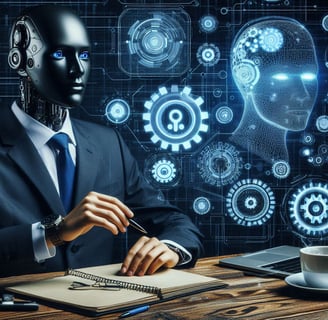Automation and AI Integration
Streamlining Operations for the Future
CLOUD ADOPTION
2/3/20251 min read


Automation and AI Integration – Streamlining Operations for the Future
Automation and AI are transforming business operations, boosting efficiency and innovation. If you're looking to integrate these technologies into your business, here's how to get started:
1. Identify Automation Opportunities
Begin by identifying repetitive tasks that can be automated, such as:
Customer Support: Chatbots handle basic inquiries, improving response times.
Data Entry: Robotic Process Automation (RPA) eliminates manual data entry errors.
Billing: Automating invoicing increases accuracy and cash flow efficiency.
Estimated Time: 2-3 weeks for initial task identification.
2. Start Small with AI Tools
Pilot smaller automation and AI projects to prove value. Implement solutions like:
Chatbots for customer support.
AI-driven analytics for insights into business data.
RPA for automating basic administrative tasks.
Estimated Time: 1-3 months for a successful pilot.
3. Develop Broader AI Use Cases
Once you’ve piloted smaller projects, explore broader AI applications:
Predictive Analytics: Use AI to forecast customer trends and product demand.
Personalization: Tailor customer experiences using AI to analyze behavior.
Fraud Detection: Leverage AI to spot suspicious activity in transactions.
Estimated Time: 2-4 months to implement more complex use cases.
4. Integration with Existing Systems
Ensure your AI and automation tools integrate with existing systems such as CRM software or ERP platforms. This seamless integration is essential for smooth workflows and accurate data flow across departments.
Estimated Time: 3-6 months depending on system complexity.
5. Measure and Optimize
Continuously track the performance of your AI and automation systems. Monitor KPIs like time saved, error reduction, and employee feedback to ensure the tools are delivering value. Regular updates will keep your systems efficient.
Estimated Time: Ongoing, with reviews every 3-6 months.
Conclusion:
Automation and AI can enhance productivity, reduce costs, and drive innovation. By identifying key tasks to automate, starting small, and ensuring seamless integration, businesses can harness the full potential of these technologies.
Next Post in the Series:
In our next post, we’ll discuss Building a Data-Driven Culture and how data can help businesses make smarter decisions.
Estimated Total Time for Automation and AI Integration: 6 months to 1 year, depending on scope.


